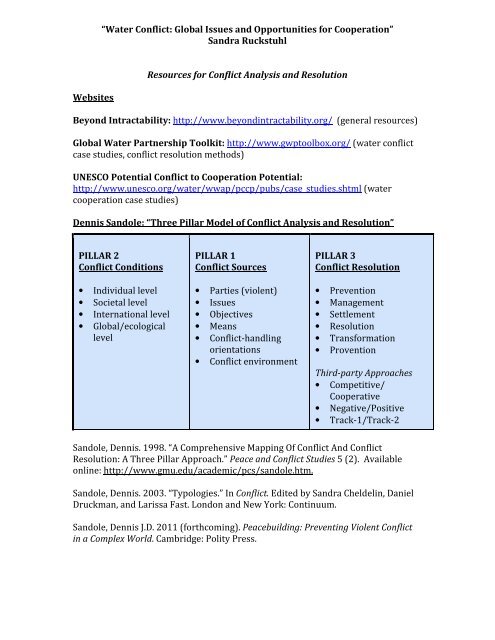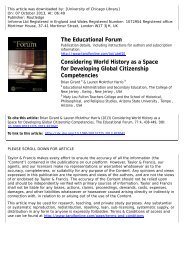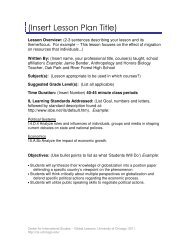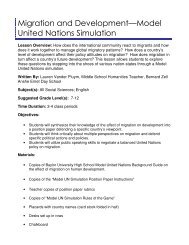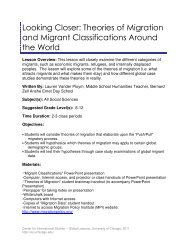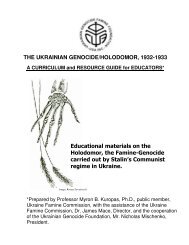Resources for Conflict Analysis and Resolution - Center for ...
Resources for Conflict Analysis and Resolution - Center for ...
Resources for Conflict Analysis and Resolution - Center for ...
- No tags were found...
You also want an ePaper? Increase the reach of your titles
YUMPU automatically turns print PDFs into web optimized ePapers that Google loves.
“Water <strong>Conflict</strong>: Global Issues <strong>and</strong> Opportunities <strong>for</strong> Cooperation”<br />
S<strong>and</strong>ra Ruckstuhl<br />
Websites<br />
<strong>Resources</strong> <strong>for</strong> <strong>Conflict</strong> <strong>Analysis</strong> <strong>and</strong> <strong>Resolution</strong><br />
Beyond Intractability: http://www.beyondintractability.org/ (general resources)<br />
Global Water Partnership Toolkit: http://www.gwptoolbox.org/ (water conflict<br />
case studies, conflict resolution methods)<br />
UNESCO Potential <strong>Conflict</strong> to Cooperation Potential:<br />
http://www.unesco.org/water/wwap/pccp/pubs/case_studies.shtml (water<br />
cooperation case studies)<br />
Dennis S<strong>and</strong>ole: “Three Pillar Model of <strong>Conflict</strong> <strong>Analysis</strong> <strong>and</strong> <strong>Resolution</strong>”<br />
PILLAR 2<br />
<strong>Conflict</strong> Conditions<br />
• Individual level<br />
• Societal level<br />
• International level<br />
• Global/ecological<br />
level<br />
PILLAR 1<br />
<strong>Conflict</strong> Sources<br />
• Parties (violent)<br />
• Issues<br />
• Objectives<br />
• Means<br />
• <strong>Conflict</strong>-h<strong>and</strong>ling<br />
orientations<br />
• <strong>Conflict</strong> environment<br />
PILLAR 3<br />
<strong>Conflict</strong> <strong>Resolution</strong><br />
• Prevention<br />
• Management<br />
• Settlement<br />
• <strong>Resolution</strong><br />
• Trans<strong>for</strong>mation<br />
• Provention<br />
Third-party Approaches<br />
• Competitive/<br />
Cooperative<br />
• Negative/Positive<br />
• Track-1/Track-2<br />
S<strong>and</strong>ole, Dennis. 1998. “A Comprehensive Mapping Of <strong>Conflict</strong> And <strong>Conflict</strong><br />
<strong>Resolution</strong>: A Three Pillar Approach.” Peace <strong>and</strong> <strong>Conflict</strong> Studies 5 (2). Available<br />
online: http://www.gmu.edu/academic/pcs/s<strong>and</strong>ole.htm.<br />
S<strong>and</strong>ole, Dennis. 2003. “Typologies.” In <strong>Conflict</strong>. Edited by S<strong>and</strong>ra Cheldelin, Daniel<br />
Druckman, <strong>and</strong> Larissa Fast. London <strong>and</strong> New York: Continuum.<br />
S<strong>and</strong>ole, Dennis J.D. 2011 (<strong>for</strong>thcoming). Peacebuilding: Preventing Violent <strong>Conflict</strong><br />
in a Complex World. Cambridge: Polity Press.
Christopher Mitchel: SPITCEROW<br />
1. What are the SOURCES (or origins) of this conflict Violent conflict did not begin yesterday, so here, write<br />
the objective history of the conflict. You can write down both sides <strong>and</strong> try to find the truth between both or any<br />
other method that eliminates the bias in what people tell you about the conflict. The emotions around the conflict<br />
need to be commented on <strong>and</strong> added to the mosaic of the total image of the conflict.<br />
2. Who are the PARTIES to this conflict There are usually primary <strong>and</strong> secondary parties to a conflict. First<br />
list the primary parties <strong>and</strong> their positions objectively. Be sure to include secondary parties because these are<br />
often more important than we give them credit <strong>for</strong> <strong>and</strong> can prolong <strong>and</strong> intensify or shorten <strong>and</strong> diminish violence<br />
in the conflict.<br />
3. What are the ISSUES of this conflict What are people arguing or fighting about There is usually more<br />
than one issue <strong>and</strong> you should list all of them because not always is the principal issue the one that is presented to<br />
us. Occasionally you have to dig deep <strong>and</strong> find that there was actually another issue that was more important than<br />
the one that everyone thought was the main issue of the conflict.<br />
4. What are the TACTICS being used by the various parties Look around <strong>and</strong> find out who is doing what <strong>and</strong><br />
saying what. What is going on between the two main sides that is leading this conflict towards violence Tactics<br />
often have little or nothing to do with ending violence or solving conflicts; expose destructive tactics <strong>and</strong> ask all<br />
to refrain from using them. See where other tactics would be more helpful. This is an important part of the<br />
process <strong>and</strong> we will return to it later.<br />
5. What, if anything, has CHANGED as the conflict developed over time Many times a conflict will start<br />
over something <strong>and</strong>, in the course of time, the cause will disappear but the conflict will continue. If you can see<br />
how things have changed over time <strong>and</strong> what new elements have been brought into the conflict, your vision will<br />
be much more clear.<br />
6. How did the conflict ENLARGE This is similar to the previous question but now you are isolating aspects<br />
that made the conflict bigger <strong>and</strong> more dangerous. What made people angrier <strong>and</strong> what can be done about it In<br />
the process of stopping violence, this is usually the place where you have to concentrate first: something made<br />
people fight when they were talking be<strong>for</strong>e. What was that something <strong>and</strong> what can be done to undo it or<br />
neutralize that something<br />
7. What ROLES did other parties play <strong>and</strong> how did this affect the continuation of the conflict The secondary<br />
parties, we said, were important because they influenced the conflict. Now we must look at what they did, how<br />
they did it <strong>and</strong> what effect did that have on the conflict. If the effect was negative <strong>and</strong> contributed to violence or<br />
confusion can that party undo what they did Can you undo what they did Are they getting something out of<br />
making the conflict worse What are they getting out of it there may be other parties that are interested in<br />
helping you to reduce violence <strong>and</strong> solve the conflict also.<br />
8. What has been the OUTCOME of the conflict up to now Although this question is more useful in<br />
analyzing conflicts that have finished (historical conflicts), the usefulness <strong>for</strong> present conflicts is that it requires an<br />
objective evaluation of where everyone is at. If there is no outcome to speak of because the conflict is raging,<br />
then you can draw an image-objective of what you would like the outcome to be so that everyone can go home<br />
happy <strong>and</strong> alive.<br />
9. Who can be said to have been the WINNERS of the conflict up to now If the conflict is being won by<br />
someone then there may be reasons <strong>for</strong> keeping the conflict going that are not easily obvious. If the fighting is<br />
over <strong>and</strong> the winner is a minority or the weaker party, then the conflict may not yet be over; if it has been well<br />
resolved good but make sure that conflicts are really over be<strong>for</strong>e leaving them. There are many aspects to<br />
conflicts that smolder like hot ashes after a fire <strong>and</strong> can re-ignite at a moments notice. Ensure that is not the case<br />
here.<br />
Abstracted from: “Analyzing <strong>Conflict</strong>s.” Chapter 2: Prevention of <strong>Conflict</strong>s <strong>and</strong> Man-made Disasters.<br />
Manual <strong>for</strong> Emergency Response in Man-made Disasters. Online at:<br />
http://www.disaster2development.com/index.php/view/307/Appendix_2_C_3_Analyzing_<strong>Conflict</strong>s


